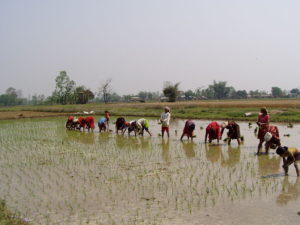Nepal: Persistent Farming Troubles
 Farmers in Nepal have suffered under continued financial stress following the Nepal Earthquake of April 2015. In the Kathmandu Valley, farmers lost their livestock, seeds, and tools as a result of the earthquake. These losses have been exacerbated by India’s recent blockade, which has dramatically increased the price of fuel and farming tools. Farmer Bhunti Ramtyal is an example of the plight that many farmers in the region face: he lost half of his home to the earthquake and can no longer afford to buy seeds and fertilizer after prices rose by 80 percent in the past year.
Farmers in Nepal have suffered under continued financial stress following the Nepal Earthquake of April 2015. In the Kathmandu Valley, farmers lost their livestock, seeds, and tools as a result of the earthquake. These losses have been exacerbated by India’s recent blockade, which has dramatically increased the price of fuel and farming tools. Farmer Bhunti Ramtyal is an example of the plight that many farmers in the region face: he lost half of his home to the earthquake and can no longer afford to buy seeds and fertilizer after prices rose by 80 percent in the past year.
The struggling farmers represent larger difficulties troubling the economically crucial agricultural industry of Nepal. The International Labor Organization reports that the industry composes thirty-four percent of the country’s GDP and employs sixty-eight percent of the population. However, the United States Agency for International Development reports that due to the lack of “improved seeds, new technologies and market opportunities,” the agricultural sector has been on the decline, harming the economy and causing hunger and migration.
Currently, the government is working with other actors to improve situations in Nepal. Scidev.net reports that scientists are conducting research on the improvement of indigenous seeds to increase biodiversity in crops. In January, the Nepali government also instituted a new Agriculture Development Strategy to address “farmer’s rights and seed sovereignty.” However, the government has failed to prioritize the initiative, which many farmers in rural areas have not yet even heard of. Seed farmer Bishnu Bahadur Rawal comments, “It would be better if the policy is revised and reformed after considering inputs from farmers. Farmers do not know much about the policy.”
However, advancements in the field of renewable energy are providing a more optimistic outlook for the agricultural industry. Organizations such as iDE Nepal and SunFarmer have helped to install a Solar Water MUS (Multiple Use System) in Syangja, which has increased water accessibility for farmers. Farmers in the Kavrepalanchok and Patlekhet districts have also learned to employ “climate-smart” practices by lining ponds with plastic to gather rainfall for irrigation.
As forty percent of Nepalese children under five are stunted and twenty-nine percent are underweight, according to the WHO, it is clear that the Nepali government must prioritize food security. Considering the ineffectiveness of certain agricultural policies, the best course of action for the government may be to invest in new technologies and renewable energy to repair damages caused by the earthquake and to improve agricultural production for the country as a whole.
